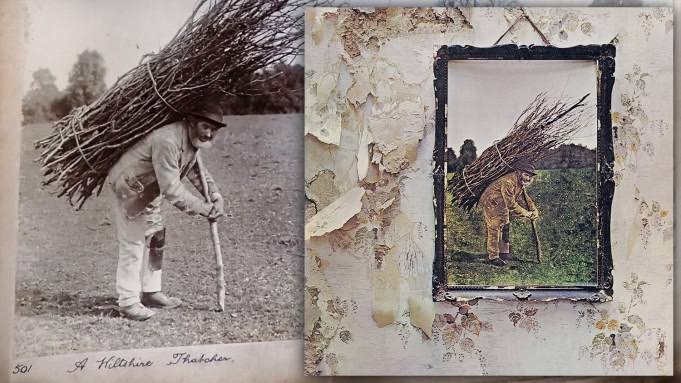The image is the iconic cover of Led Zeppelin’s untitled fourth studio album, commonly referred to as Led Zeppelin IV or Zoso, released in 1971. Unlike conventional album covers that prominently display the band’s name and album title, this one is devoid of any text, adding to its mystique and allowing the art to speak for itself. At the center of the front sleeve is a worn, framed painting of an elderly man hunched over, carrying a bundle of sticks on his back. This seemingly humble and rustic image was purchased by lead singer Robert Plant at an antique market in Reading, England, and later photographed and incorporated into the album’s artwork.
The painting, hung on a peeling wall in a dilapidated interior, contrasts sharply with the modern urban decay suggested by the surrounding setting. This juxtaposition symbolizes a connection between the old and the new, a deliberate evocation of the past within the context of a changing and increasingly industrialized world. The band’s decision to feature this image, along with the complete absence of any written information, was a statement against the commercialism of the music industry. They wanted the music to be judged on its own merit, without preconceived notions or the influence of their growing fame.
Inside and on the reverse of the album, each member is represented by a unique, self-chosen symbol, most notably Jimmy Page’s “Zoso” glyph, which has contributed to the album’s alternative title. These symbols deepen the album’s esoteric and mythic atmosphere, further detaching it from mainstream marketing strategies.
Musically, Led Zeppelin IV is a tour de force, containing some of the band’s most legendary tracks, including the epic “Stairway to Heaven,” the driving “Black Dog,” the bluesy “Rock and Roll,” and the thunderous “When the Levee Breaks.” The album blends hard rock, folk, blues, and mysticism in a way that helped define the genre and solidify Led Zeppelin’s status as rock icons.
The cover’s quiet, pastoral imagery stands in stark contrast to the powerful and expansive sound within, creating a tension that enhances its legendary status. Decades later, it remains one of the most recognizable and celebrated album covers in rock history.










